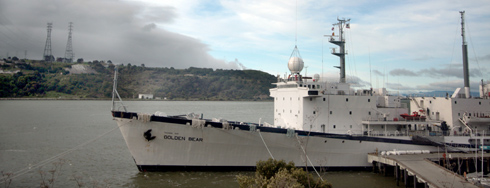Nearly one hundred Longshore Caucus delegates voted to support a resolution calling for an eight-hour "stop work" meeting during the day-shift on Thursday, May 1 at Bay Area ports to protest the war by calling for the immediate, safe return of U.S. troops from Iraq.

California Maritime Academy training ship Golden Bear in Vallejo as new satellite antenna is lowered into place.
By Paul Duclos
Published: April, 2008
The Caucus has spoken on this important issue and I’ve notified the employers about our plans for ‘stop work’ meetings on May 1, said ILWU International President Bob McEllrath.
Caucus delegates, including several military veterans, spoke passionately about the importance of supporting the troops by bringing them home safely and ending the war in Iraq. Concerns were also raised about the growing cost of the war that has threatened funding for domestic needs, including education and healthcare. Nobel prize-winning economist Joseph Stiglitz and Harvard economist Linda J. Bilmes recently estimated that the true cost of the War in Iraq to American taxpayers will exceed 3 trillion dollars—a figure they describe conservative.
New Satellite Antenna Installed On Cal Maritime Vessel
The profile of the California Maritime Academy training ship Golden Bear has been altered with the addition of a new satellite antenna—13 feet high and 12 feet in diameter—that will enable the ship to better communicate with the Cal Maritime campus and the world during its training voyages. One of the largest benefits of the new antenna will be live, always-on Internet connections onboard the ship.
According to Stephen Frazier, the Chief Information Officer at Cal Maritime, the new system will help address many of the problems that affected ship-to-shore communications in the past. First, we expect emails to move back and forth in near real-time with minimal delays. In the past, we had to collect outgoing and incoming email traffic and move it in batches a couple of times each day. Our limited bandwidth meant we couldn’t send most file attachments, including pictures or other critical files. With the new system, campus users will be able to continue using their own campus email accounts on board, and won’t have to change over to special shipboard addresses. This alone will be a big help in reducing the workload on campus IT staff.
We think families and friends of cadets, as well as prospective students, will really like the chance to see more of what makes the cruise such a vital part of the overall educational experience at Cal Maritime. An improved user interface will make it easier to find popular features like daily activity reports, candid photos, the shipboard Bear’s Tale, and the Captain’s Log. Visitors to the campus website (www.csum.edu) will find a link to this feature, which will be posted before the ship departs on the first of its two cruise legs, Sunday, April 27th.
This year’s training voyage will visit island ports of the South Pacific, including Tahiti, Tonga, New Caledonia and Hawaii.
Bay Area Seaports Unite in Anti-Pollution Campaign
The Oakland Board of Port Commissioners has authorized the Port of Oakland’s Executive Director to sign an agreement for a Bay Area Seaports Air Emissions Inventory. The new regional agreement names a Steering Committee comprised of the San Francisco Bay Planning Coalition, the Bay Area Air Quality Management District (Air District), and five Bay Area ports. The committee members will coordinate future efforts to reduce air emissions from port related activities, a statewide priority for the California Air Resources Board (CARB). Reducing pollution is vital to the health of our neighbors and our region, said Port Board President Anthony Batarse.
Port of Oakland Executive Director Omar Benjamin stated, This regional approach, and the establishment of a steering committee of all major Bay Area port authorities, will ensure success of this agreement and contribute to improving air quality for all of us. It represents another major step in our collaborative work to cut air pollution and support a healthy community.
The Bay Area Seaports Air Emissions Inventory will make it possible to evaluate the collective emissions from ports on the bay. We have worked very hard to reduce air pollution on Port of Oakland property, said Jerry Serventi, Director of Engineering, Port of Oakland, who serves as President of the S.F. Bay Planning Coalition. Bringing together all of the key members of the Bay Area’s maritime industry to complete a detailed inventory of air emissions data will enable the Air District and industry to determine how best to reduce maritime related air quality impacts on a regional scale.
The purpose of the San Francisco Bay Planning Coalition is to facilitate the efforts of the steering committee members in developing these upcoming reports of air-quality emissions. The information will be used as the basis for policy decisions in connection with the Air District’s Green Ports Initiative and other efforts to reduce emissions.

